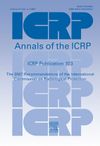The primary aim of The System of Radiological Protection is:
“to contribute to an appropriate level of protection for people and the environment against the detrimental effects of radiation exposure without unduly limiting the desirable human actions that may be associated with such exposure” (ICRP Publication 103 paragraph 26)

|
For people, exposures are managed and controlled to:
- Prevent Harmful effects that are, in principle, preventable
- Reduce the risk of cancer and heritable effects to the extent reasonably achievable
|
For the environment, the aim is to have a negligible impact on:
- the maintenance of biological diversity
- the conservation of species
- the health and status of natural habitats, communities and ecosystems
|

|
Quotes from ICRP Publications
ICRP Publication 103 paragraph 29
The Commission’s system of radiological protection aims primarily to protect human health. Its health objectives are relatively straightforward: to manage and control exposures to ionising radiation so that deterministic effects are prevented, and the risks of stochastic effects are reduced to the extent reasonably achievable.
Types of effects: ICRP Publication 103 paragraph 55
Most adverse health effects of radiation exposure may be grouped in two general categories:
- deterministic effects (harmful tissue reactions) due in large part to the killing/ malfunction of cells following high doses; and
- stochastic effects, i.e., cancer and heritable effects involving either cancer development in exposed individuals owing to mutation of somatic cells or heritable disease in their offspring owing to mutation of reproductive (germ) cells.
|
ICRP Publication 103 paragraph 30
... The Commission’s aim is now that of preventing or reducing the frequency of deleterious radiation effects to a level where they would have a negligible impact on the maintenance of biological diversity, the conservation of species, or the health and status of natural habitats, communities and ecosystems. In achieving this aim, however, the Commission recognises that exposure to radiation is but one factor to consider, and is often likely to be a minor one ...
ICRP Publication 103 paragraphs 7 and 8
... The biological endpoints of most relevance are therefore those that could lead to changes in population size or structure. Nevertheless, radiation affects individuals, and most available data on the effects of radiation relate to individuals rather than populations.
The biological endpoints of interest to individuals that could have a consequence at a population level are those of:
- early mortality (leading to changes in age distribution, death rate, and population density);
- some forms of morbidity (that could reduce ‘fitness’ of the individuals, making it more difficult for them to survive in a natural environment);
- impairment of reproductive capacity by either reduced fertility or fecundity (affecting birth rate, age distribution, number, and density); and
- induction of chromosomal damage.
|
 Read on to learn about the Fundamental Principles of Radiological Protection
Read on to learn about the Fundamental Principles of Radiological Protection
See Also


![]() Read on to learn about the Fundamental Principles of Radiological Protection
Read on to learn about the Fundamental Principles of Radiological Protection

